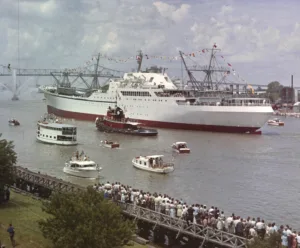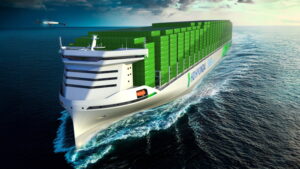Nuclear Shipping Greenhouse Gas Emissions
In 2018 the International Maritime Organization (IMO) adopted the aim of reducing greenhouse gas emissions from shipping by 50% by 2050 compared with 2008. It is estimated that shipping accounts for 2.6% of global CO2 emissions. In 2017 global bunkering totalled 8.9 EJ, with 82% being heavy fuel oil and the balance marine gas oil and diesel. In 2018 the global shipping fleet had a capacity of 2 Gt and it transported 8.9 Gt of freight. In the backdrop of fresh regulations on CO2, SOx and NOx options for clean naval propulsion need to be broached as despite efforts the only already sea proven emissions-free energy is nuclear power of the pressurised water reactor type.
Intergovernmental Panel on Climate Change
 Credit;IEEE Spectrum
Credit;IEEE Spectrum
According to the Intergovernmental Panel on Climate Change, approximately 15 % of net anthropogenic greenhouse gas emissions originate from the transportation sector. Almost all of the world’s commercial fleets still run on diesel fuel. The shipping industry consumes some 350 million tonnes of fossil fuel annually and accounts for about 3 % of total worldwide carbon emissions. In 2024 the shipping industry at the behest of IMO approved new targets for greenhouse gas emission reductions aiming to reach net-zero emissions by or around 2050.
Advent of Nuclear Powered Commercial Shipping
Four nuclear-powered merchant ships have been built so far, all of them government sponsored projects primarily for developmental and testing reasons rather than purely commercial ones. The first was the American NS Savannah constructed in the fifties at a cost of $46.9 million (translated into $495 million at today’s inflation rate). It was in service from 1962 to 1972, but its pressurised light-water reactor (LWR) proved too complex and expensive for the ship to operate profitably. The Russian cargo vessel Sevmorput, commissioned in 1988, is the only nuclear-powered merchant ship still in operation .The other two ships, the Japanese Mutsu (1970) and the German Otto Hahn (1968), were both refitted with diesel engines during their operational life
Commercial Transport
Merchant ships operate under different types of commercial contracts, and .the most common types being:
1) Time Charter (TC), where a charterer hires the ship for a given time period and usually shipowner covers fuel costs.
2) Spot, where a charterer hires a ship for a given voyage on short term notice and usually the charterer pays for the fuel.
3)Contract of Affreightment (COA), where a shipowner promises to transport a certain amount of cargo at given times in the future. Example is transporting of 10 million tons of iron ore from a given port in Brazil to China in 2025. The Charterer usually pays for the fuel.
Nuclear Related Regulations
Chapter VIII of the International Convention for the Safety of Life at Sea (SOLAS), 1974 contains inter-alia the basic requirements for nuclear-powered ships. In 1981 the IMO adopted the Code of Safety for Nuclear Merchant Ships, Resolution A.491(XII), which can be updated . The purpose of the safety code was to provide guidelines and recommendations for flag states. According to chapter seven in the code, crew members should have sufficient competence to perform their assigned duties on board the vessel and fulfil the requirements in the operating manual for the relevant reactor to be used on board the vessel. In the case of merchant ships with nuclear propulsion, the following additional skills listed below are requirements for the engineering officers and should be part of an education and training program approved by the administration
Commercial Nuclear Reactors
Nuclear merchant ships are merchant vessels powered by nuclear reactors, offering potentially long ranges and reduced refueling needs. While nuclear propulsion has been successfully implemented in naval vessels its application to commercial shipping is limited, with only a few prototypes built and operated. Over 160 ships are powered by more than 200 small nuclear reactors.
Russian Advancement Nuclear Powered Merchant Vessels
Mostly submarines but may range from icebreakers to aircraft carriers. Nuclear propulsion has proven technically and economically essential in the Russian Arctic where operating conditions are beyond the capability of conventional icebreakers. The power levels required for breaking ice up to 3 metres thick, coupled with refuelling difficulties for other types of vessels remain significant factors. The Russian nuclear fleet, with 6 nuclear icebreakers and a nuclear freighter, has increased Arctic navigation from 2 to 10 months per year, and in the western Arctic to year-round. In 2020 Rosatom said it has accumulated 400 reactor-years of operating experience with icebreakers.
Nuclear Refuelling
 Credit;WWN
Credit;WWN
For civilian Russian icebreakers the refueling procedures could possibly mirror the expected procedure for civilian merchant ships .As the ship and reactor are designed for a fuel change, the refueling process itself is not a complicated process that normally takes place every 5 years on an average depending on the reactor’s operational history. However, since refueling would require docking the ship, cooling the reactor for weeks and then replacing the fuel ,a complete reactor core fuel consumption (the level of burn-up and how much of the fissile material could be used). Currently there is an experience of about 700 nuclear naval reactors worldwide for military use and about 200 nuclear naval reactors are still in operation . The nuclear power also allows enhanced flexibility in ship design as a relatively smaller volume is required. Nuclear vessels operation is more flexible due to less frequent refueling.
Nuclear Water Reactors
The most successful design is the pressurized water reactors, which have proven to be simple, safe and compact, becoming the dominant solution. Those characteristics are interesting for merchant ships permitting space for goods deadweight. Nowadays nuclear power plants with pressurized water reactors reach safety levels far beyond the first generation and costs have being reduced if compared with designs of the nineties. Yet drawbacks remain like high capital cost, proliferation issues and rigorous nuclear standards mainly objective oriented while merchant ships standards are prescriptive and they are constantly subjected to nuclear authorities’ inspections.
Radioactive Waste & Contamination
Deep knowledge in the nuclear field and about nuclear classified shore installations are required enhancing the global costs for a small number of ships, along with the problem of ownership of nuclear waste. Public opinion turned against nuclear energy after Chernobyl and Fukushima accidents and many countries proceeded to abandon nuclear energy and nuclear merchant ships and NS Otto Hahn and NS Sevmorput encountered many restrictions for berthing at ports. Despite all drawbacks studies indicate that it is in theory, economically feasible to employ nuclear energy for large commercial ships.
Nuclear Risks
In the future constraints on fossil fuel use in transport may induct marine nuclear propulsion into widespread use. Piracy and Yemen based Houthi rebel attacks in the Red Sea on commercial shipping using drones, missiles, rocket-propelled grenades and small arms fire remains a cause of concern. Exaggerated fears about safety have caused political restriction on port access. The post-9/11, Three Mile Island, Chernobyl and Fukushima world security and safety scenario is vastly different from the 20th century political and social environment in which the first generation of nuclear ships were developed. The potential for a reactor accident, albeit low must be considered. Proponents argue that use of new fuels such as TRi-structural ISOtropic (or TRISO) pellets, which the US Energy Department claims to be the most robust fuel ever created, and concepts such as low-pressure molten salt reactors make the spread of contamination from an accident far less likely than was the case with the high-pressure, water-cooled reactors that are used in use in military naval ships. Such arguments tend to overlook that commercial ships are invariably sailing and surrounded by water. If there is leakage, waterborne contamination could be extremely difficult to detect initially and contain, potentially threatening expanded areas and raising concerns about commercial fishing.
Nuclear Ship Hull
Nuclear propulsion of commercial shipping also creates unique risks. In contrast to military vessels designed to resist damage, commercial ships are relatively thin-skinned and not nearly as damage-tolerant as military hulls. In addition to the risk of terrorist or wartime attacks, nuclear-powered commercial vessels face the risks of collision, grounding and weather-related damage. Different types of radioactive waste must be grouped according to their characteristics. For example, waste containing radionuclides with short half-lives (usually defined as those whose half-life is reckoned in seconds, minutes or hours [58]) may be separated from waste containing radionuclides with longer half-lives, or compressible waste may be separated from non-compressible waste. Thus, according to its activity and half-life, radiological waste may be classified in different groups.
Challenges
Naval ships are largely self-contained and deploy reactor crew that is too large for commercial chips of any sort due to both the availability of crew as well as cost issues . Therefore, remote monitoring/operations is seen as key enabler. include high costs, regulatory hurdles and public perception, but advancements in reactor technology and ongoing studies suggest a potential future for nuclear powered merchant ships.
Korean Nuclear Shipyards
The design for nuclear powered ship was revealed at the New Nuclear for Maritime Houston Summit, held at the Asia Society Texas Center in Houston, USA. Previously, HD Korea Shipbuilding & Offshore Engineering (HD KSOE) obtained Approval in Principle (AIP) from the American Bureau of Shipping (ABS) for a 15,000 TEU-class container ship design model applying small modular reactor (SMR) technology. The HD KSOE , a subsidiary of HD Hyundai , shared that the newly unveiled design model features contain enhanced economic efficiency and safety by incorporating actual equipment and safety design concepts. Unlike conventional ships, nuclear-powered vessels do not require engine exhaust systems or fuel tanks. The company has optimised the space previously occupied by large engine room equipment to accommodate additional containers, enhancing economic efficiency. It has also applied a marine radiation shielding system using a double-tank method with stainless steel and light water to ensure safety. In South Korea, KEPCO Engineering & Construction is developing the BANDI-60S as a 200 MWt/60 MWe two-loop PWR particularly for floating nuclear power plants. In September 2020 KEPCO signed an agreement with Daewoo Shipbuilding & Marine Engineering to develop offshore nuclear power plants.Additionally HD KSOE, in collaboration with global energy technology company Baker Hughes, has applied a supercritical carbon dioxide-based propulsion system, improving thermal efficiency by about 5% compared with existing steam-based propulsion systems. HD KSOE plans to establish a marine nuclear demonstration facility at its Future Technology Test Centre in Yongin, Gyeonggi Province, to verify safety designs and aim to develop a marine nuclear business model by 2030.
Floating Nuclear SMR Barge and Offshore
In October 2023, a design for a floating offshore nuclear power barge from HD KSOE and Kepco Engineering & Construction (Kepco E&C) received approval in principle from ABS. Project collaborators included ABS, HD KSOE, Kepco E&C and the Liberian International Ship & Corporate Registry. The floating SMR barge is intended to serve as offshore power generation for remote communities and island electrification.
Lloyd’s Hyundai
In January 2024, a memorandum of understanding was signed between Lloyd’s Register, Zodiac Maritime, HD KSOE and Kepco E&C for the development of nuclear-propelled ship designs, including bulk carriers and container ships. Under the joint development project, HD KSOE and Kepco E&C will provide designs for future vessels and reactors while Lloyd’s Register will assess rule requirements for safe operation and regulatory compliance models. HD Hyundai has already invested USD $ 30 million in TerraPower for a reactor to be jointly developed which centres around TerraPower’s Molten Chloride Fast Reactor (MCFR) design. An iteration of the MCFR – known as the m-MSR – intended for marine use is being developed by TerraPower. Fourth-generation small modular reactors (SMRs) being developed by companies including U.S.-based TERRA Power and London-based NEWCLWO should be safer and simpler to operate than conventional reactors.
Batteries and Ammonia
Batteries as a fuel source remain nonstarter as large container ship needs about 3,000 megawatt-hours a day almost equal to the capacity of the biggest grid battery ever built. Using Ammonia as fuel entails additional costs as it has half the energy density of diesel fuel and ships would need twice as much of fuel storage. Ammonia is presently produced through an energy-intensive process and no vessels are properly capable of using it. Producing enough renewable, carbon-free ammonia for shipping, about 600 million tonnes a year using electrolyzers that split water molecules to produce hydrogen, would use 12 megawatt-hours per tonne of ammonia. To make 600 million tonnes of Ammonia it would require almost three times the annual power production capacity of the entire European Union . Ammonia can be used in a variety of marine engines, including dual-fuel engines that can switch between ammonia and conventional fuels. Its high energy density and low viscosity make it a suitable option for long-range shipping operations.The widespread advocacy for adoption of ammonia as a marine fuel faces challenges related to storage and bunkering infrastructure. Safe and efficient handling of ammonia requires specialised equipment and facilities, which are currently limited in the shipping industry.
Author ; Nadir Mumtaz
Trademark Blue Economy IPO-PK
Credit;
https://www.world-nuclear-news.org/articles/korean-smr-powered-container-ship-design-revealed
https://spectrum.ieee.org/nuclear-powered-cargo-ship
https://www.vard.com/assets/Documents/NuProShip-I-Final-Report-2024-12-31-compressed_Optimized.pdf
https://doi.org/10.1016/j.nucengdes.2015.07.031 ,
https://www.sciencedirect.com/science/article/abs/pii/S0029549315003015

Leave A Comment